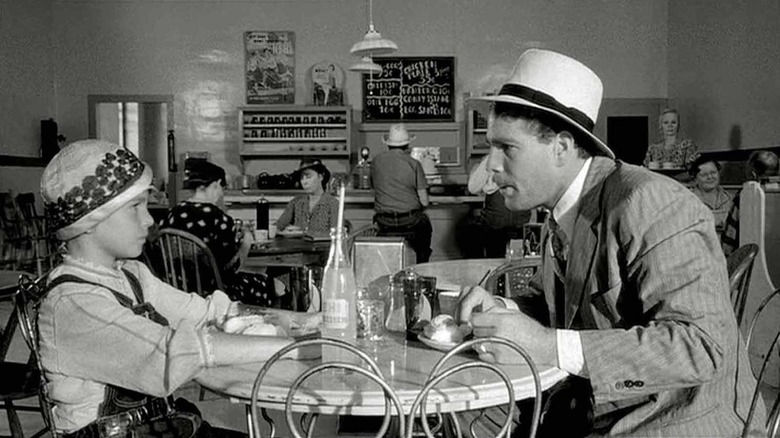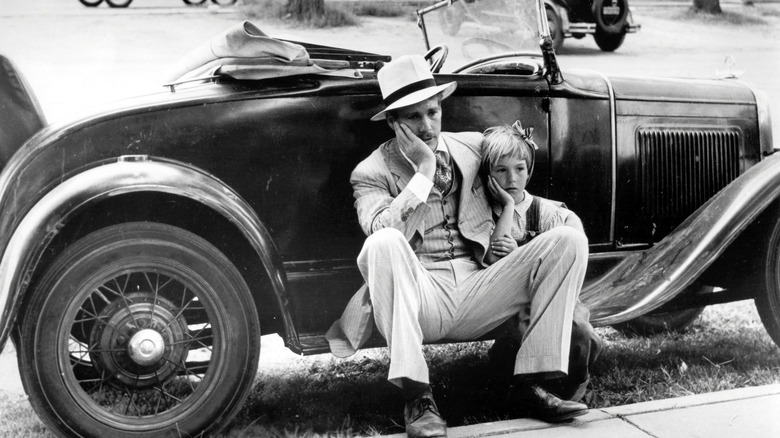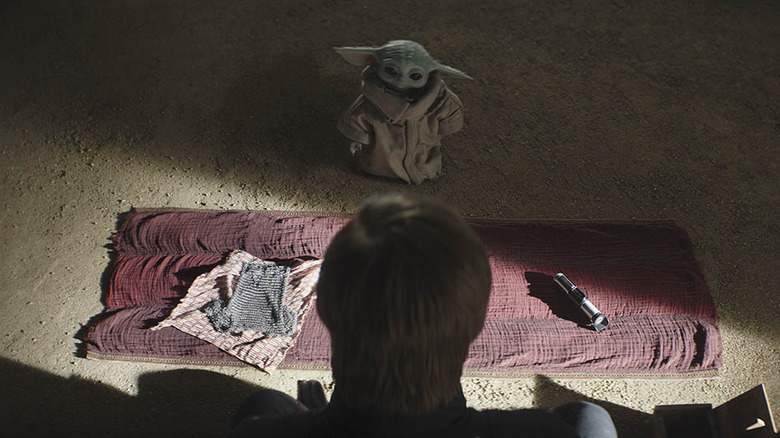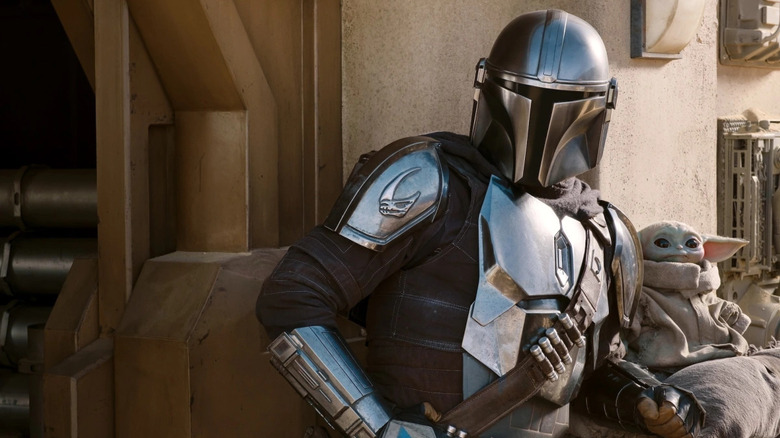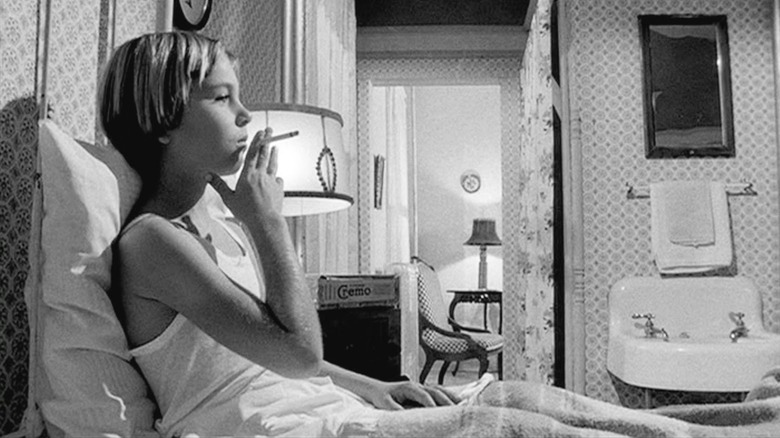The Mandalorian Took Unlikely Inspiration From Peter Bogdanovich's Paper Moon
(Welcome to The Movies That Made "Star Wars," a series where we explore the films and television properties that inspired George Lucas' iconic universe. In this edition: Peter Bogdonavich's masterpiece "Paper Moon.")
When you think of "The Mandalorian," the primary cinematic influence that comes to mind might be the Japanese classic series "Lone Wolf and Cub." The relationship between Din Djarin and Grogu is very reminiscent — at least in early seasons — of Itto Ogami and his toddler son Daigoro. The choice given to Grogu by Luke Skywalker, where he must choose between the way of the Jedi and the way of the Mandalorians, is a shot-for-shot recreation of the choice Ogami gives Daigoro in the films. He's to choose between a ball or the sword in "Lone Wolf and Cub," rather than a beskar shirt or a lightsaber. We talked about the influences of "Lone Wolf and Club" in a previous installment, here.
As Grogu chooses to rejoin the Mandalorian in "The Book of Boba Fett," Jon Favreau had another movie on his mind, though. And that was Peter Bogdonavich's masterpiece "Paper Moon."
Paper Moon
Set in the 1930s, "Paper Moon" tells the story of a grifter named Moses Pray played by Ryan O'Neal who travels from place to place running cons for money. At the beginning of the film, he finds himself at a funeral that's left a young girl named Addie (played by O'neals own daughter Tatum, who won the Academy Award for her portrayal) orphaned. Smelling opportunity for cons, Moses agrees to take the girl to her family in Missouri. He convinces her relatives to cough up $200 for her, then he tries to buy her a train ticket and give her $20 and send her on her way. She's a lot more strong-willed than that and demands her $200.
Unable to get rid of the girl without causing a scene and since she's too sharp to accept his grifting, Moses reluctantly takes her with him. As he goes to earn her money back, they discover she's adept at pulling cons herself and they start working as a team.
They go through their adventures and manage to lose all of their money by the time they get to Missouri. There, Moses deposits Addie with her distant relative, just like he said he would. But that's not where Addie belongs, and she reunites with Moses, despite his better judgement, and they go back to their life, presumably.
It's a terrific movie, sharp in its dialogue, and perfectly orchestrated by Peter Bogdonavich. The atmosphere of the depression era bleeds off the screen, and Ryan O'Neal and his daughter Tatum have a genuine chemistry that can't be faked. Tatum O'Neal is absolutely magnetic in the film, easily as good as Grogu is as a foil to Din Djarin on "The Mandalorian."
The Book of Boba Fett
In "The Book of Boba Fett," Luke Skywalker gives Grogu a choice. He can choose the life of a Jedi and eschew his attachment to Din Djarin, or he can go choose the way of the Mandalorian and forgo his Jedi training altogether. Ultimately, Grogu chooses the path of the Mandalorian and races after his adoptive father faster than Addie goes after Moses in "Paper Moon."
Reunited on Tatooine, the Mandalorian and Grogu once again reforge their bond, knowing that they shouldn't have been separated in the first place.
It's easy to see the influence of "Lone Wolf and Cub" on this moment — Luke Skywalker offering Grogu the choice is shot-for-shot taken out of that movie and manga series — but according to Jon Favreau, "Paper Moon" was just as influential on this moment.
As Jon Favreau set out to do press for the third season of "The Mandalorian," he talked about the nature of found-family movies that resonated with him down to his core in the 1970s. "The Bad News Bears" and "Paper Moon" were the two on the tip of his tongue when I talked to him.
The Mandalorian and Paper Moon
"Your subconscious is really a product of all your influences, and 'Paper Moon' was a very strong influence on me, and a lot of movies at the time period," Favreau said to me in a press roundtable.
"I grew up with the 'Bad News Bears,' and I grew up with 'Paper Moon' and films like that. There were such interesting relationships of misfits who feel like they don't belong anywhere, but these family relationships emerge, and then the family relationships are often stronger than the bloodline relationships, and that's certainly a hallmark of 'Star Wars.'"
Favreau then connected this idea to "A New Hope," chiding me to look at Han Solo's arc:
[Han Solo is] somebody who seems to be very selfish, and I think that progression from selfishness to living for something and sacrificing for people or somebody something bigger than yourself is very much a part of 'Star Wars.' We're communal species, cooperative species, and we are rewarded when we act in that way, when we think about things that are more important than just our own individual needs.
'Paper Moon' is such a wonderful film because you think it's all about transporting this character, you know, to their living relative after their mother passes away. And the idea that when she finally gets delivered to where she belongs, you realize now that journey was what reinforced it. And that bond was what was important for both of them, and so the unexpected twist of her leaving behind this cushy life that she could have had and going and being a con artist with Ryan O'Neal, I find unexpected and fulfilling and [a] really satisfying ending."
Watch the movie
"Paper Moon" is nothing short of a masterpiece. It's just a terrific film on every level and is worth watching. For fans of "The Mandalorian," it will be a treat to see how something that seems so out of left field could be influential to "Star Wars." Watching it, though, and thinking about the relationship between Din and Grogu, the influence and inspiration is undeniable.
"We do find influences in cinema, stylistically," Favreau told me, "but also story-wise, because great stories have been told before, and 'Star Wars' is a wonderful way to encapsulate a lot of what came before and serve it up to a new generation in a slightly different context."
It's nothing short of fascinating to see how a movie like this, an unadulterated and heartwarming comedy, can influence something as gritty as "The Mandalorian." My advice is to see "Paper Moon" as you continue your journey watching "The Mandalorian." It's going to give you more context for the relationship between the titular Mandalorian and his tridactyl ward, but it's also just a great film.
You won't be disappointed.
"The Mandalorian" is currently streaming on Disney+. You can stream "Paper Moon" on Amazon Prime or rent or buy it wherever you get movies.
